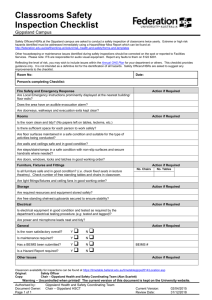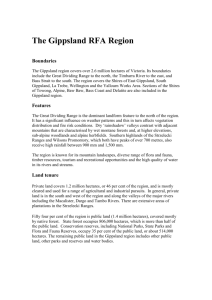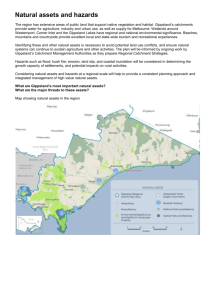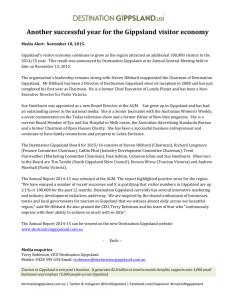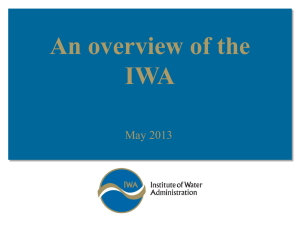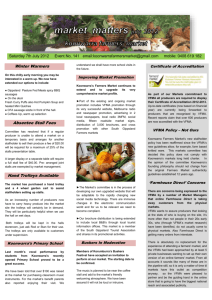MINISTERIAL DIRECTION - East Gippsland Shire Council
advertisement
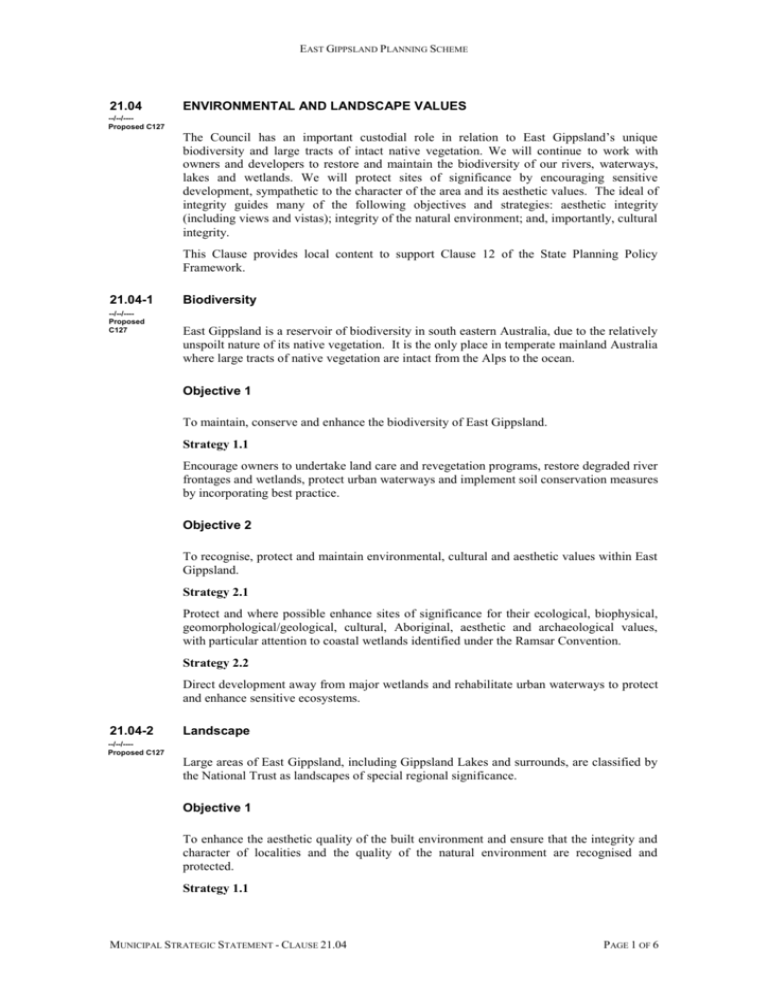
EAST GIPPSLAND PLANNING SCHEME 21.04 --/--/---Proposed C127 ENVIRONMENTAL AND LANDSCAPE VALUES The Council has an important custodial role in relation to East Gippsland’s unique biodiversity and large tracts of intact native vegetation. We will continue to work with owners and developers to restore and maintain the biodiversity of our rivers, waterways, lakes and wetlands. We will protect sites of significance by encouraging sensitive development, sympathetic to the character of the area and its aesthetic values. The ideal of integrity guides many of the following objectives and strategies: aesthetic integrity (including views and vistas); integrity of the natural environment; and, importantly, cultural integrity. This Clause provides local content to support Clause 12 of the State Planning Policy Framework. 21.04-1 --/--/---Proposed C127 Biodiversity East Gippsland is a reservoir of biodiversity in south eastern Australia, due to the relatively unspoilt nature of its native vegetation. It is the only place in temperate mainland Australia where large tracts of native vegetation are intact from the Alps to the ocean. Objective 1 To maintain, conserve and enhance the biodiversity of East Gippsland. Strategy 1.1 Encourage owners to undertake land care and revegetation programs, restore degraded river frontages and wetlands, protect urban waterways and implement soil conservation measures by incorporating best practice. Objective 2 To recognise, protect and maintain environmental, cultural and aesthetic values within East Gippsland. Strategy 2.1 Protect and where possible enhance sites of significance for their ecological, biophysical, geomorphological/geological, cultural, Aboriginal, aesthetic and archaeological values, with particular attention to coastal wetlands identified under the Ramsar Convention. Strategy 2.2 Direct development away from major wetlands and rehabilitate urban waterways to protect and enhance sensitive ecosystems. 21.04-2 Landscape --/--/---Proposed C127 Large areas of East Gippsland, including Gippsland Lakes and surrounds, are classified by the National Trust as landscapes of special regional significance. Objective 1 To enhance the aesthetic quality of the built environment and ensure that the integrity and character of localities and the quality of the natural environment are recognised and protected. Strategy 1.1 MUNICIPAL STRATEGIC STATEMENT - CLAUSE 21.04 PAGE 1 OF 6 EAST GIPPSLAND PLANNING SCHEME Ensure that development in significant landscape areas is designed and implemented in a way that is sympathetic to character of the area and preserves its aesthetic values. Strategy 1.2 Protect: Areas of high landscape sensitivity, including visually prominent ridgelines, areas adjacent to the coastline or lake shorelines and remnant vegetation in generally cleared areas. Landscapes with high aesthetic or cultural values as identified by the National Trust of Australia (Victoria) (Map 2). Views from significant lookout points. Scenic roads, including those referenced in the Forest Management Plan, East Gippsland Forest Management Area, the Forest Management Plan for Gippsland, the East Gippsland Forest Management Zoning and the Gippsland Lakes Strategy (Map 3). Attractive landscapes and important vistas, through development and application of siting and design guidelines for coastal townships, recreation activity centres and other areas of high landscape quality. Strategy 1.3 Protect and, where possible, enhance the visual and environmental qualities of coastal, lakeshore and river-frontage areas. Strategy 1.4 Facilitate applications for development in residential areas proximate to Mitchell River and Mitchell River Backwater to appropriately respond to the environmental and landscape characteristics of the active floodplain. 21.04-3 Urban Waterways --/--/---Proposed C127 Objective 1 To protect and enhance the ecological health of urban waterways. Strategy 1.1 Ensure revegetation, appropriate treatment of stormwater, provision of habitat and adherence to other best practice principles identified in the East Gippsland Shire Council Urban Waterway Guidelines. Strategy 1.2 Encourage design of infrastructure works, including roads and services, that limits impact on flora and fauna. Strategy 1.3 Ensure new infrastructure is not constructed in a waterway in a manner preventing free movement of fish, reptiles and/or frogs where habitat for such fauna exists upstream and downstream of the structure. Strategy 1.4 Encourage revegetation of land near waterways to enhance bank stability, habitat corridors and water quality. Strategy 1.5 Encourage development proposals that avoid direct discharge of stormwater flows into waterways. MUNICIPAL STRATEGIC STATEMENT - CLAUSE 21.04 PAGE 2 OF 6 EAST GIPPSLAND PLANNING SCHEME Strategy 1.6 Encourage development proposals that demonstrate post-development waterway discharge will be maintained relative to pre-development levels. MUNICIPAL STRATEGIC STATEMENT - CLAUSE 21.04 PAGE 3 OF 6 EAST GIPPSLAND PLANNING SCHEME MAP 2 SIGNIFICANT REGIONAL LANDSCAPES MUNICIPAL STRATEGIC STATEMENT - CLAUSE 21.04 PAGE 4 OF 6 EAST GIPPSLAND PLANNING SCHEME MAP.3. SCENIC ROADS MUNICIPAL STRATEGIC STATEMENT - CLAUSE 21.04 PAGE 5 OF 6 EAST GIPPSLAND PLANNING SCHEME Implementation The strategies in relation to Environment and Landscape Values will be implemented through the planning scheme by: Policy Guidelines When considering proposals for new uses or developments on land adjacent to National Parks, State Forests, Coastal Parks or other Crown Land, take into account the possible impacts upon these areas, as well as the potential for private land to complement opportunities available in the public sphere. When considering applications for new development or infrastructure, take into account policy and best practice principles included in the East Gippsland Shire Council Urban Waterway Guidelines. When considering applications for new development or infrastructure, take into account policy and design principles included in the Bairnsdale Growth Strategy, November (2009). Application of Zones and Overlays Applying Rural Conservation Zone to rural areas to defend their natural conservation values. Applying the Public Conservation and Resource Zone on Crown land river frontages and national and regional parks, state forests and nature conservation reserves. Applying the Environment Significance Overlay to areas required for watercourse protection, groundwater recharge protection areas. Applying the Vegetation Protection Overlay to protect those areas of significant roadside vegetation, wildlife corridors and native vegetation. Applying the Significant Landscapes Overlay to protect significant coastal landscapes. Other Actions Implement the Roadside Vegetation Management Plan (2012). Reference Documents Roadside Vegetation Management Plan (2012) Forest Management Plan, East Gippsland Forest Management Area (DCNR, 1995) Forest Management Plan for Gippsland (DSE, 2004) The East Gippsland Forest Management Zoning Review (2011) East Gippsland Shire Council Urban Waterway Guidelines (EGSC March 2013) Bairnsdale Growth Strategy, November (2009) MUNICIPAL STRATEGIC STATEMENT - CLAUSE 21.04 PAGE 6 OF 6
